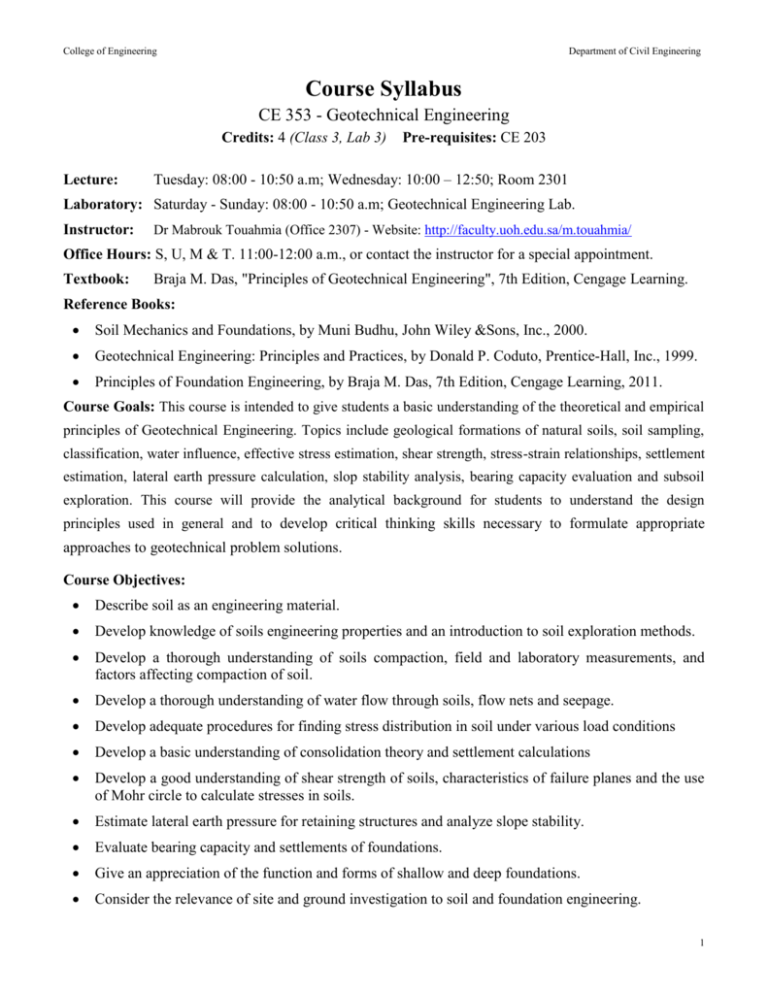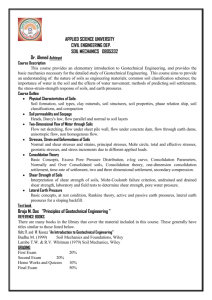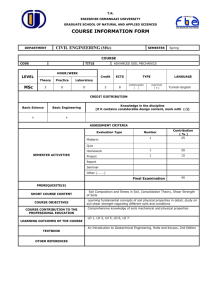Syllabus
advertisement

College of Engineering Department of Civil Engineering Course Syllabus CE 353 - Geotechnical Engineering Credits: 4 (Class 3, Lab 3) Lecture: Pre-requisites: CE 203 Tuesday: 08:00 - 10:50 a.m; Wednesday: 10:00 – 12:50; Room 2301 Laboratory: Saturday - Sunday: 08:00 - 10:50 a.m; Geotechnical Engineering Lab. Instructor: Dr Mabrouk Touahmia (Office 2307) - Website: http://faculty.uoh.edu.sa/m.touahmia/ Office Hours: S, U, M & T. 11:00-12:00 a.m., or contact the instructor for a special appointment. Textbook: Braja M. Das, "Principles of Geotechnical Engineering", 7th Edition, Cengage Learning. Reference Books: Soil Mechanics and Foundations, by Muni Budhu, John Wiley &Sons, Inc., 2000. Geotechnical Engineering: Principles and Practices, by Donald P. Coduto, Prentice-Hall, Inc., 1999. Principles of Foundation Engineering, by Braja M. Das, 7th Edition, Cengage Learning, 2011. Course Goals: This course is intended to give students a basic understanding of the theoretical and empirical principles of Geotechnical Engineering. Topics include geological formations of natural soils, soil sampling, classification, water influence, effective stress estimation, shear strength, stress-strain relationships, settlement estimation, lateral earth pressure calculation, slop stability analysis, bearing capacity evaluation and subsoil exploration. This course will provide the analytical background for students to understand the design principles used in general and to develop critical thinking skills necessary to formulate appropriate approaches to geotechnical problem solutions. Course Objectives: Describe soil as an engineering material. Develop knowledge of soils engineering properties and an introduction to soil exploration methods. Develop a thorough understanding of soils compaction, field and laboratory measurements, and factors affecting compaction of soil. Develop a thorough understanding of water flow through soils, flow nets and seepage. Develop adequate procedures for finding stress distribution in soil under various load conditions Develop a basic understanding of consolidation theory and settlement calculations Develop a good understanding of shear strength of soils, characteristics of failure planes and the use of Mohr circle to calculate stresses in soils. Estimate lateral earth pressure for retaining structures and analyze slope stability. Evaluate bearing capacity and settlements of foundations. Give an appreciation of the function and forms of shallow and deep foundations. Consider the relevance of site and ground investigation to soil and foundation engineering. 1 College of Engineering Department of Civil Engineering Course Outline: LECTURE TOPICS Reading Assignement 1 Historical Development of Geotechnical Engineering -Geologic Engineering, Soil Mechanics, Geotechnical Engineering - Rock Cycle, Rock Types, and Origin of Soil - Soil Particle Size and Shape. Weight-Volume Relationships (Phase Relationships), Relative Density Soil Consistency, Atterberg Limits - Engineering Classification of Soil. Soil Compaction, Proctor Test, Field Compaction, Special Compaction Techniques. Permeability, Bernoulli’s Equation, Darcy’s Law, Hydraulic Conductivity, Laboratory Determination of Soil Conductivity, Permeability Test in the Field. Seepage, Groundwater Flow, Laplace’s Equation of Continuity, Flow Nets, Uplift Pressure under Hydraulic Structures, Seepage through an Earth Dam. In Situ Stresses, Stresses in Saturated Soil, Effective Stresses in partially Saturated Soil, Capillarity Rise in Soils. Stresses in Soil Mass, Normal and Shear Stresses on a Plane, Vertical Stress Caused by Different Loading, Influence Chart. Compressibility of Soil, Contact Pressure and Settlement, Fundamentals of Consolidation, 1-D Laboratory Consolidation Test, Calculation for Settlement from 1-D Primary Consolidation, Secondary Consolidation Settlement, Time Rate Consolidation, Evaluation of (Cv), Calculation of Consolidation Settlement under a Foundation. Shear Strength of Soil, Mohr-Coulomb Failure Criterion, Direct Shear Test, Triaxial Shear Test, (C-D) (C-U) (U-U) Triaxial Tests, Empirical Relationships Between (Cu) and (o’), Shear Strength of Unsaturated Cohesive Soils, Stress Path. Lateral Earth Pressure, At Rest, Active and Passive Pressure, Rankin’s Theory of Active and Passive Pressures, Diagrams for Lateral-Earth Pressure Distribution Against Retaining Wall, Coulomb’s Active and Passive Pressures, Common Types of Retaining Walls. Retaining Walls with Friction, Procedure for Determining Passive Earth Pressure (Pp)-Cohesionless Backfill, Coefficient of Passive Earth Pressure (Pv), Determination of Active Thrust on Bracing Systems, Pressure Variation for Design of Sheetings, Struts and Walls. Slop Stability, Modes of Slop Failure, Factor of Safety, Analysis of Finite Slopes with Plane Failure Surface, Culmann’s Methods, Bishop’s Simplified Method of Slices, Stability Analysis by Method of Slices for Steady-State Seepage, Morgenstern’s Method of Slices for Rapid Drawdown Condition, Fluctuation of Factor of Safety of Slopes in Clay Embankment on Saturated Clay. Chapter 1 & 2 2 3 4 5 6 7 8 9 10 11 12 13 Chapter 3 Chapter 4 & 5 Chapter 6 Chapter 7 Chapter 8 Chapter 9 Chapter 10 Chapter 11 Chapter 12 Chapter 13 Chapter 14 Chapter 15 2 College of Engineering Department of Civil Engineering LECTURE 14 15 TOPICS Reading Assignement Soil Bearing Capacity, Foundations, Soil-Bearing Capacity for Shallow Chapter 16 Foundations, Terzaghi’s Ultimate Bearing Capacity Equation, Effect of Groundwater Table, Factor of Safety, A Case History for Evaluation of the Ultimate Bearing Capacity. Subsoil Exploration, Planning for Soil Exploration, Boring Methods, Chapter 18 Common Sampling Methods, Sample Disturbance, Correlations for Standard Penetration Test, Other In Situ Tests, Soil Exploration Report. Intended Educational Outcomes: Upon successful completion of this course, students should be able to: Quantify soils engineering and physical properties. Experiment with standard laboratory soil test equipment to determine soil properties. Examine the importance of soil characteristics to the design of soil-support structures through engineering classification and mechanical behavior of soils. Conduct compaction experiments and decide acceptance criteria for field compaction. Analytically solve flow problems in soils. Solve problems involving seepage problems. Calculating effective stresses due to seepage forces. Calculate stresses in a soil mass under various load conditions. Understand the concept of soil consolidation and calculate soil settlement. Quantify soils shear strength using laboratory experiments. Estimating the lateral earth pressure for retaining structures. Analyzing slope stability. Evaluating soils bearing capacity. Analyze soil mechanics related engineering problems using theoretical and empirical geotechnical methods. Conducting subsoil exploration program for a given structure. Course Assessment The grade for the class will be based on attendance, two scheduled in-class exams, several unannounced quizzes, homework, laboratory reports and a final exam as follows: Points: 100% total Attendance Major Exam 1 Major Exam 2 Quizzes Homework Laboratory Reports Final Exam (%) 5 15 15 10 5 20 30 5% 15% 15% 10% 5% 20% 30% 3







